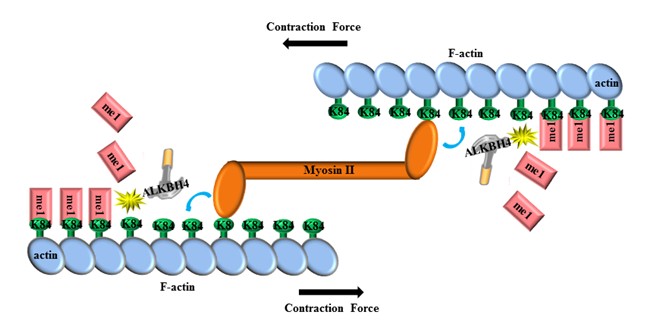Recently, the lab of Prof. YANG Yungui from Beijing Institute of Genomics, Chinese Academy of Sciences, in collaboration with Prof. Klungland Arne from University of Oslo, revealed that the dioxygenase ALKBH4-dependent demethylation of actin regulates actomyosin dynamics, which was published in Nature Communications on May 14, 2013. Eukaryotic cytokinesis requires actomyosin-based contraction at the cleavage furrow to physically divide a mother cell into two daughter cells. The determination of the plane and position of the cleavage furrow during cytokinesis requires communication between microtubules and the actin cortex, which results in the assembly of F-actin (the filamentous form of actin) and non-muscle Myosin II (NM II) into contractile ring. The contractile ring is a highly dynamic structure with a rapid turnover of both F-actin and NM II. NM II is the major motor protein in cytokinesis and its movement along F-actin and F-actin depolymerization are required for furrow ingression. Ingression of the cleavage furrow proceeds by actomyosin-mediated force generation, but the underlying mechanism of actomyosin contraction remains largely unknown. They demonstrated that dioxygenase ALKBH4-mediated demethylation of a novel mono-methylated site in actin (K84me1) regulates actin-myosin interaction and actomyosin dependent processes including cytokinesis and cell migration. ALKBH4-dependent actin demethylation regulates actomyosin function by promoting actin-NM II interaction. ALKBH4 is recruited to the contractile ring and midbody via interaction with methylated actin and ALKBH4 mediates demethylation of actin K84me1 and thus creates a binding site for NM II. Consecutive demethylation of actin moieties in the actin filament could then allow dynamic sliding of NM II along the actin filaments and mediate contraction of the contractile ring, resulting in cleavage furrow ingression and subsequent abscission. Thus this study sheds light on the mechanistic underpinnings of cytokinesis. Schematic model (Image by Prof. Yang Yungui) Contact:ygyang@big.ac.cn Paper link: http://www.nature.com/ncomms/journal/v4/n5/pdf/ncomms2863.pdf
